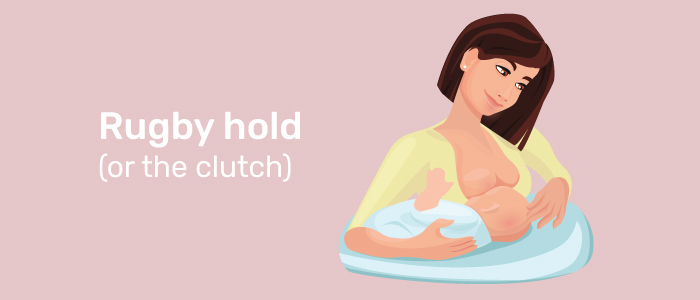Breastfeeding Positions
In this article:
- Ensuring a Good Latch
- Basic Steps For Breastfeeding Positioning
- Breastfeeding Positions
- Laid-back breastfeeding (biological nurturing)
- The Cradle Position (sitting down)
- Side-Lying Position (lying down)
- Rugby hold (the Clutch)
- Breastfeeding after a Caesarean Section
- Alternatives and Extras

Choosing the Right Breastfeeding Position for You and Your Baby
Breastfeeding is a skill that takes practice: it requires time and patience and it can be challenging to work out which feeding positions feel most comfortable, especially in the early days. You should try different positions to see which feels best for you and your baby, and remember, there definitely aren’t any ‘correct’ or ‘best’ positions for breastfeeding. However, it is always important to offer both breasts and alternate breasts after every feed.
Ensuring a Good Latch
First and foremost, try to ensure baby has a good latch. This is something that will take time and doesn’t always work instantly. Remember to ask your midwife, health visitor or breast-feeding consultant to help if things remain painful and if you feel the latch isn’t working.
Tips for a good latch:
- Hold baby’s entire body close, facing you, with their nose level with your nipple.
- Allow baby’s head to tip back slightly to let their top lip touch your nipple: this should provoke a reflex which opens your baby’s mouth wide.
- When baby’s mouth opens wide, bring their chin in to touch your breast first, with their head tipped back to allow their tongue to touch as much breast as possible
- When your baby’s chin touches your breast, keep their nose clear. Their bottom lip should cover most (if not all) of the darker nipple skin (the areola) under the nipple, but you should see much more of the areola above the top lip. Baby’s cheeks should be rounded, not sucked in, and look full as they are feeding.
Over time, you will learn to recognise baby’s early feeding cues, and this will give you time to make sure you are in a good position before they become over-hungry. Early feeding cues can include moving their head side to side, opening their mouth, or sucking on their fingers/hands. Ideally, try not to wait until your baby is crying as this is a late hunger cue. If you get to this late stage, it will be more stressful for you both to get into a good position for feeding.
Basic Steps For Breastfeeding Positioning
Throughout feeding, if you ever have pain or feel uncomfortable, try unlatching baby and trying a different position. This can significantly improve breastfeeding pain. Moreover, a good latch will ensure baby has the best opportunity to co-ordinate suckling, swallowing and breathing, and ultimately reduce wind. Generally, a few hints are:
- Try to position yourself comfortably first, with a glass of water within reaching distance. Use a back support, pillows (or a breastfeeding pillow) supporting your arms and your baby, and your feet resting on a low footrest.
- Position baby close to you with their hips flexed so that they do not have to turn their head to touch the breast. Their head, mouth and nose should be in line. Hold the baby close to you so they are touching your body.
- Ensure your breast is supported so that it is not pressing onto baby’s chin. As above, their chin should touch the breast first and then their nose.
- When you are getting baby to latch, support their back and not their head: your hand can form a ‘second neck’ for your baby.
- If you feel pain, detach baby and try again.
Breastfeeding Positions
Over time, as you become more experienced with breastfeeding, you will find different positions that can be altered in many ways. If baby is nursing well and you are comfortable, there is no ‘correct position’ – just do what works for you both. Below are descriptions of some common positions you can try. However, always ensure that your baby is brought to your nipple height. Leaning over baby can cause backache, neck/shoulder problems and sore nipples.


Laid-back breastfeeding (biological nurturing)
This position encourages you and your baby’s natural breastfeeding instincts.
- Position yourself comfortably in bed, or in a recliner with back support, and good support for your head, shoulders and arms. When you lean back in a comfortable position, lay baby on your chest and gravity will keep them in position.
- Baby’s cheek should rest near your breast, then bring your baby close and try latching on – baby’s feet should be supported by your body, so they are not dangling in the air.
- Use one hand to support baby’s thighs/bottom and one hand to support your breast.
- Relax into the position and enjoy the feed.


The Cradle Position (sitting down)
This is the position most used by breastfeeding mothers after the first few weeks. However, if you’ve had a caesarean, this may not be comfortable as your baby will lie across your scar area. You could try the side-lying position or rugby hold described below.
- Baby should be lying on their side, resting on their shoulder and hip with their mouth level with your nipple. The baby’s front should entirely touch your body.
- Use pillows, or a breastfeeding pillow, to lift the height of your baby and support your elbows ensuring the baby is at nipple height and that you are not bending or stooping over. NB: try resting your feet on a stool or a low table if you are sitting in a chair to prevent backache from leaning forward.
- Support your breast by cupping it in a ‘C’ hold: your thumb on top away from the areola, with your fingers underneath the nipple.
- When you look down onto baby in this position you should see their side: their head should be resting on your forearm and their back along your inner arm
- Baby’s ear, shoulder and hip should all be in a straight line (their head and bottom should be level)


Side-Lying Position (lying down)
Some mothers find this position the easiest and most relaxing after the initial early days. It is also useful if you have had a difficult labour or a caesarean section. A lot of mothers also enjoy this position at night. Practising this in the daytime can be helpful before trying it at night when you may be more tired.
- Mother and baby lie on their sides facing each other.
- Pillows and breastfeeding pillows can be useful in this position too: they can be used to support your back, or behind or between your knees. A pillow or rolled up blanket can also be used to support baby’s back to ensure they do not roll away from you (make sure it is not too close to their head or face).
- Ensure baby’s hips are flexed and their ear, shoulder and hip are in a straight line. This will allow for easier feeding for baby.
- The arm you are lying on can be tucked under your head (or a pillow), and your top hand can be used to guide baby’s head to your nipple.


Rugby hold (the Clutch)
Breastfeeding using this position is good after a caesarean section as there is no pressure on your tummy or scar. It is also useful for twins as they can both be fed at the same time. Newborns are comfortable in this position and it is also useful if mother’s have a forceful milk ejection reflex (let down) because the baby can handle the quicker flow of milk more easily.
- Position baby at your side (the side you want to feed from) with a pillow to support your arm and their body.
- With baby’s hips close to your hips, support baby’s head in your hand, with their back along your arm.
- Baby’s nose should be level with your nipple.
- Using the palm of your hand support baby’s neck and gently guide them towards your nipple.
Breastfeeding after a Caesarean Section
It can be harder to establish breastfeeding after a C-section especially if you have pain, or if you can’t move around easily, and both you and baby may feel very tired. It may take longer for milk to come in, but once established, women who have had a section are just as likely to continue breastfeeding as those who have a vaginal birth.
Always discuss any pain you have with your healthcare provider, midwife or health visitor.
You may find variations of the positions above useful in trying to establish feeding and finding a position that is most comfortable for you.
Tips:
- Skin to skin contact within the first 24 hours, if possible, will help you bond with baby and can help you establish feeding early.
- Feed baby on demand and this will help your body produce enough milk.
- Ask for help! Don’t be afraid to ring the call bell. Ask the midwife or breastfeeding specialist on the ward for assistance if your baby has problems feeding.
- If possible, ask someone to pass baby to you so don’t have to be twisting unnecessarily to pick them up.
- When you get home, support from a family member or friend can ensure you are able to focus on establishing feeding.
- If your wound is painful use a pillow to protect it: but if it is very painful or sore, speak with your midwife or GP about pain relief.
Another complicating factor in breastfeeding after a C-section, is that babies may have a lot of mucous they are coughing up. In a vaginal birth this mucous is squeezed from the baby’s lungs, so C-section babies may be less interested in feeding or may not feed for very long each time. Therefore, it is important to keep trying to breastfeed, or express some milk every 3 hours, so that your body continues to get the signal to produce milk. Once the mucous has cleared, baby should begin to feed more regularly.
Alternatives and Extras
Some mothers find breastfeeding in a sling to be more comfortable and beneficial when ‘out and about’. The fabric of the sling can be discreet as it covers both the breast and the baby’s head. You will need to ensure that baby is in the correct position for the sling used, and that their head is at nipple height. You may need to support their head during feeding, but it does mean you can have one hand free. Speak to your health visitor or midwife about this: there may a local ‘sling library’ where you can try out different types of sling for free before you purchase one.
Remember, there are no ‘correct’ positions for breastfeeding. Ensuring a good latch is the first step in making sure your breastfeeding journey gets off to a good start. Try experimenting with different positions to see which feels best for you. If you need more help, ask your health visitor, midwife or GP. Community groups and breastfeeding cafes can also be extremely beneficial and have lots of useful information once you are home from the hospital. Your midwife and health visitor should be able to tell you what is available and local to you.
References:
La Leche League International ‘Positioning’:
https://www.llli.org/breastfeeding-info/positioning
NHS ‘Breastfeeding: positioning and attachmt’:
https://www.nhs.uk/conditions/pregnancy-and-baby/breastfeeding-positioning-attachment/
NHS Start4life ‘How to breastfeed’:
https://www.nhs.uk/start4life/baby/breastfeeding/how-to-breastfeed/breastfeeding-positions/
Tommy’s ‘Breastfeeding after a C-Section’:



